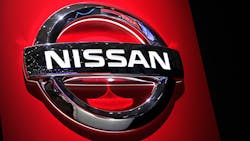Nissan CEO's `Big Burden' Is to Get US Business Back on Track
The U.S. used to be Nissan Motor Co.’s biggest source of profit, helping fund expansion plans around the globe. Now, its operation in the country is a major problem child and challenge for embattled CEO Hiroto Saikawa.
Nissan said this week that U.S. sales plunged 9.3% in the fiscal year ended in March and predicted a further drop, sending shares to their lowest since 2012. The company’s profit margin in the country has shrunk to about 1% to 2%. Saikawa, 65, called the results “rock bottom” and pledged a recovery.
“We need to revive the U.S. operation,” the chief executive officer said as Nissan reported its lowest earnings in a decade. “We have excessive capacity and unprofitable operations, which are becoming a big burden.”
The U.S. slump underscores Nissan’s broader operational challenges that have been overshadowed by the arrest of former leader Carlos Ghosn and the management turmoil that’s ensued. A rebound in the world’s largest economy is crucial for Nissan as it tries to avoid falling further behind global rivals Volkswagen AG, Toyota Motor Corp. and General Motors Co.
Saikawa blamed Nissan’s U.S. collapse on “old leaders” under Ghosn, who was arrested in November on charges of financial misconduct and fired as chairman. Saikawa has since shaken up executive ranks, with longtime North America chief Jose Munoz among those departing. Saikawa’s own position has meanwhile come under intense scrutiny from shareholders.
Nissan shares were down less than 1% in early trading in Tokyo Friday.
Growth Focus
The U.S. predicament stems from Nissan’s focus on market share. Under its “Power 88” plan announced in 2011, the carmaker sought to grow its global share to 8% by 2017. The company never set a formal target for the U.S., but executives made clear they were aiming for 10%. Nissan managed to hit that mark for part of 2017, in part by hiking incentives and fleet sales to rental-car companies.
“Setting your metrics to market share -- exclusively or predominately -- increases an opportunity where you can make decisions that result in a lower profitability for the business,” Stephanie Brinley, an analyst at IHS Markit, said by phone. “In some cases we’re seeing that Nissan may have gone in that direction.’’
When Nissan began dialing back the discounts early last year, sales slumped. Weaker demand prompted the company to cut a shift from its pickup truck and commercial van assembly lines in Canton, Mississippi, reducing the factory’s headcount by about 400 workers.
It remains to be seen if that’s going to be enough to align Nissan’s production volumes with demand. Through April, sales in the U.S. are down 8.4% this year.
In March, Denis Le Vot left the role of Nissan North America chairman after just 14 months and was replaced by Jose Luis Valls, who had been running Latin American operations.
“We need to make sure that we optimize the right way the supply and demand,” Valls said in an interview last month.
Aging Lineup
He has his work cut out for him. Analysts say Nissan’s lineup is broadly uninspiring outside a couple of standouts, and increasingly long-in-the-tooth due to a slow pace of model makeovers. The current generation Rogue crossover -- Nissan’s best seller in the U.S. -- is five years old, and the Frontier model competing in the fast-growing mid-size truck segment hasn’t been updated since 2005.
“Their vehicles have been competitive but not necessarily segment-leading,” IHS Markit’s Brinley said. “They’re not always segment-leading when it comes to how often are they refreshed.”
Nissan has pledged to redesign models that represent 70% of sales volume over a three-year period ending in 2020. It has already updated key vehicles such as the Altima sedan last year and Versa compact set to debut this summer, and will likely soon announce revamps of the Rogue and Frontier mid-sized truck. In April, the Altima and Rogue were the company’s best-selling vehicles in the U.S., accounting for nearly half of its 95,698 units in total monthly volume.
Saikawa said a reduced reliance on fleet sales and incentives are set to make Nissan’s business more sustainable. He plans to bring annual sales back to 1.4 million units, with pure retail volumes accounting for most of the rebound.
The pain the company will have to go through now is comeuppance for aggressive incentives and selling to fleets that artificially inflated sales for years, said Steve Kalafer, a former Nissan dealer.
“All they did was defer reality,” Kalafer, who was a Nissan dealer for 36 years and now sells vehicles under the carmaker’s Infiniti brand, said in January. “Reality has come, and reality is very expensive.”
About the Author
Bloomberg
Licensed content from Bloomberg, copyright 2016.
